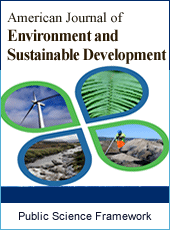American Journal of Environment and Sustainable Development
Articles Information
American Journal of Environment and Sustainable Development, Vol.2, No.1, Mar. 2017, Pub. Date: Jun. 15, 2017
Water Quality Classification of the Karaj River Based on a Biological Index
Pages: 11-15 Views: 2767 Downloads: 1207
[01]
Seyed Hadi Khatami, Division of Human Environment, Department of the Environment, Bureau of Environmental Impact Assessment, Tehran, Iran.
The Karaj River is one of the most important rivers in Iran that provide potable water for Tehran City. The purpose of this study was to determine the water quality of the Karaj River based on the BMWP biotic index along the river from Gachsar village to the Amirkabir Dam. Four Phyla, 4 Classes, 4 Orders and 21 Families of macro-invertebrates were identified via the collected samples. There was a significant difference (P=0.03; n=4) between the BMPW indices recoreded during summer and autumn. This could be due to decreasing chanel size and differences in the discharge of pollutants between the two seasons. The result of cluster analysis showed three distinct groups of sites. The results of the biological survey showed that, although the quality of the water is influenced is pollution, the impact is not at the level that could seriously the use of the river water for potable consumption.
Karaj River, Macro-Invertebrates, Biological Monitoring Working Party (BMWP) Index
[01]
Abel, P. D, (1980), "Toxicity of *-hexachlorocyclohexane (Lindane) to Gammarus pulex: mortality in relation to concentration and duration of exposure", Freshwater Biology, 10, 251-259.
[02]
Abel, P. D. (1989). Water Pollution Biology. John Wiley & Sons. New York, Chichester, Brisbane, Toronto.
[03]
Balloch, D., Davies, C. E. & Jones, F. H. (1976). Biological assessment of water quality in three British rivers: the North Esk (Scotland), the Ivel (England) and the Taff (Wales). Water Pollution Control, 75, 92-110.
[04]
Beck, M. W. Jr, (1954), "Studies in stream pollution biology", I. A simplified ecological classification of organisms. Qarterly Journal Florida Academy of Sciences, 17, 211-227.
[05]
Begon, M., J. L. Harper & C. R., Townsend, 1990. Ecology; Individuals, Populations and Communities. Second Edition. Blackwell Scientific Publications, Oxford, 945pp.
[06]
Brinkhurst, R. O. (1966). The Tubificidae (Oligochaeta) of pollution waters. Verhandlungen der Internationalen Vereinigung fur Theoretische und Angewandte Limnologie, 16, 854-859.
[07]
Chandler, J. R. (1970). A biological approach to water quality management. Water Pollution Control, 4, 415-422.
[08]
Dussart, C. B. J., Mycock, E. R. & Scott, D. (1980). An alternative biological water quality index. Speculation in Science and Technology, 3 (2), 157-165.
[09]
Egglishaw, H. J, (1980), "Benthic invertebrates of streams on the Alburz Mountain range near Tehran, Iran". Hydrobiologia, 69(1-2): 49-55.
[10]
Goodnight, C. J. & Whitley, L. S. (1960). Oligochaetes as indicators of pollution. Proceedings of American Waste Conference Purdue University, 15, 139-142.
[11]
Hellawell, J. M, (1986), "Biology Indicators of Freshwater Pollution and Environmental Management", Elsevier Applied Science Publishers, London, New York.
[12]
Hilsenhoff, W. L. (1988). Rapid field assessment of organic pollution with a family-level biotic index. Journal of the North American Benthological Society, 7 (1), 65-68.
[13]
Hynes, H. B. N., 1970. The Ecology of Running Waters. Liverpool University Press, 555pp.
[14]
Khatami, S. H. (2007). Classification of the Karaj River quality based on a biotic index. Islamic Republic of Iran, Water Research Institute. Ministery of Energy, Water Resources Management CO. (WRMC), Applied Research Plan.
[15]
Learner, M. A., Densem, J. W. & Iles, T. C. (1983). A comparison of some classification methods used to determine benthic macro-invertebrate on data obtained from the River Ely, South Wales. Freshwater Biology, 13, 13-36.
[16]
Mason, C. F, (1991), "Biology of Freshwater Pollution", John Wiley & Sons, New York.
[17]
National Water Council. (1981). River Quality: the 1980 survey and future outlook. National Water Council, London.
[18]
Pantle, R. & Buck, H, (1955), "Die biologische Überwachung der Gewässer und die Darstellung der Ergebnisse", Gas-v. Wasserfach, 96, 604.
[19]
Randerson, P. F., 1993. Ordination. In J. C. Fry (ed.). Biological data analysis. A practical approach. Oxford University Press: 173-217.
[20]
Sokal, R. R. & P. H. A. Sneath, 1963. Principals of numerical taxonomy. W. H. Freeman & Co., San Francisco, 359pp.
[21]
Whashington, H. G. (1984). Diversity, biota and similarity indices. A review with special relevance to aquatic ecosystems. Water Research, 18, 653-694.
[22]
Whitehurst, I. T, (1991), "The Gammarus: Asellus ratio as an index of organic pollution", Water Research, 25 (3), 333-340.
[23]
Woodiwiss, F. S, (1964), "The Biological System of stream classification used by the Trent River Board", Chemistry and Industry, 11, 443-447.

ISSN Print: Pending
ISSN Online: Pending
Current Issue:
Vol. 6, Issue 4, December Submit a Manuscript Join Editorial Board Join Reviewer Team
ISSN Online: Pending
Current Issue:
Vol. 6, Issue 4, December Submit a Manuscript Join Editorial Board Join Reviewer Team
| About This Journal |
| All Issues |
| Open Access |
| Indexing |
| Payment Information |
| Author Guidelines |
| Review Process |
| Publication Ethics |
| Editorial Board |
| Peer Reviewers |


